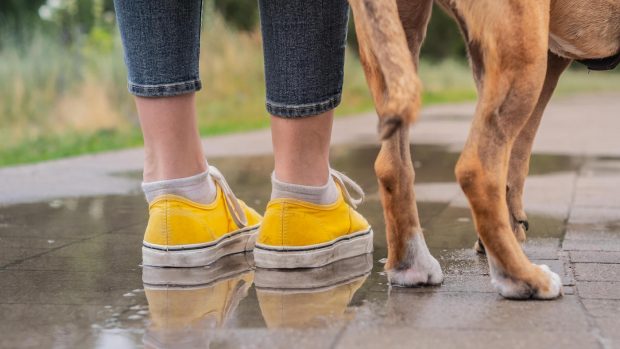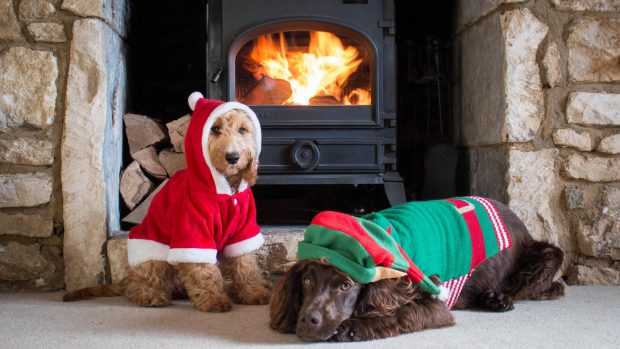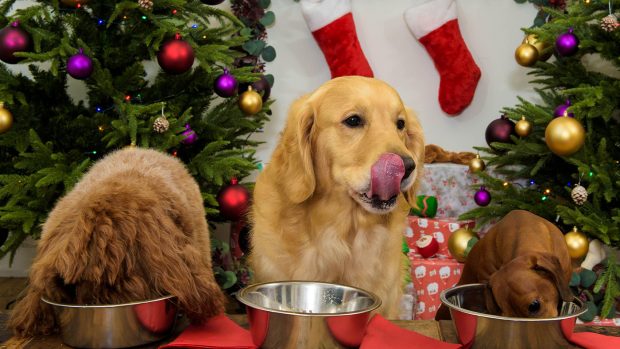If you’re thinking about when to bath a puppy for the first time, the answer is often to use your common sense and the truth is it varies. As a breeder of English Mastiffs, I start washing them with a warm flannel and some dog shampoo diluted in a bowl when they start walking and rolling about. I avoid taking over from the mother, who in my case was cleaning them till they went out the door to new homes, but puppies do tend to be blissfully unaware of what they’ve been rolling when playing so can get pretty mucky.
Over-bathing can wash the oils and ruin the coats of certain hardier breeds. They have a coat for a reason – they are waterproof and some breeds originate in colder climates or are outdoor working breeds are double coated, too, so are not designed to be continually washed.
I bathe the mastiffs when they’re moulting and usually if they have trunked through filthy, muddy puddles or (worst case scenario) fox poo! My Irish Terrier puppy, Gladys, is quite unique – and from the minute I got her home she has been trying to (with some success) jump in my bath. She likes nothing more than to have a wash in warm water before being wrapped in a towel and falling fast asleep. However, I have had to teach her (and shut the bathroom door), not to get in my bath every day. She is a double-coated breed that requires hand stripping, so it would not be good for her skin or her coat to be bathed that often.
When can you bath a puppy?
For most puppies, unless they have rolled in something hideous or its autumn/winter and very muddy, I would tend to wait until the first fear period is over, which is between 8–11 weeks. At this stage, I suggest starting with an inch or two of water in a bath and gently spill the water over them with a cupped hand or a jug to get used to the process. You can get lick mats that stick to the bath (like this one on Amazon), which help to occupy them in a positive way while you begin the bathing process. Another method I use to help dogs get used to the feeling of warm water is to get a warm damp flannel and start wiping them down once or twice a week during that first fear period of 8-11 weeks.
Once you have bathed the puppy once or twice in a few inches of water with a jug, you can start putting on the shower at a low pressure and gently use it around their tummy and legs in the first instance to desensitise them to the feeling. I then gradually work my way up and around the puppy over two to three sessions. Throughout this process, rewarding your puppy at various points when they are coping, listening and getting used to the procedure. It’s very important that a dog feels secure during the bathing process so make sure that it is not slippery. Use a rubber mat in the bath (like this one on Amazon) and potentially the floor, too, when you lift them out to dry, and hold them securely as you possibly can while bathing. Having an assistant will help with this – and if you’re unsure, check out our tips for how to wash a dog.

Lick Mats With Suction Pads | Amazon.co.uk
Keep your pup occupied with a lick mat that’s stuck to the side of the bath.

Non-slip Bath Mat | Amazon.co.uk
Prevent your dog from sliding around with a non-slip bath mat.

Pet Bath Tub | Amazon.co.uk
Available in four sizes, this tub has a drain feature for easy emptying.
How to bath a puppy: tips
I am very fortunate to work with a close group of professionals in many dog spheres and the lady I trust above all others to bathe, groom and strip my dogs is Kate Ball, owner of Doggie Styles Professional Grooming in Headcorn, Kent. She also helps with lots of my clients’ dogs. Here are her top tips for bathing and grooming your pups:
- Bath at home initially, rather than in a strange environment.
- Use lots of praise but don’t make it a game – especially the drying part when they want to get the zoomies and rub against everything.
- Use one of the best puppy shampoos that is gentle on the skin and coat as their coats change dramatically as they mature.
- If you have a long-haired dog, brush from head-to-toe after the bath and during drying.
- Use only a towel on short- and smooth-coated breeds. On the longer haired breeds, use a handheld hairdryer on a warm setting while brushing through at the same time. Again, make this a positive experience by including enrichment toys and lick mats. You can start getting your puppy used to a hairdryer the minute you get it home every time you dry your own hair. Begin with letting them get used to the sound and watching you, then lower the speed and the temperature and run it over them once or twice and reward to aid desensitisation.
- Always rinse thoroughly.
- Use one of the best conditioning shampoos on the longer coated breeds to help with any tangles. Make sure the bath and the drying area are non-slip.
- Make sure you are prepared. Have the grooming brushes, dog shampoo, towels, enrichment toys and treats all set up ready so you are not fishing around for things and adding stress. Have the non-slip mats in place and the hairdryer outside ready. It is a good idea to just give them a little break before using the hairdryer to have a drink and a treat.
- Book your dog in for a puppy groom experience once you’ve taken some of these steps to introduce bathing.
You may also enjoy reading…

Rub-a-dub-dub: how to wash a dog

Squeaky clean: dog shampoos to wash, condition and nurture healthy coats

6 super shampoos to make your stinky dog come out smelling of roses

11 hacks to eliminate bad doggy smells

Best dog grooming brushes for luscious locks and shiny coats

Sleek and shiny: best dog conditioners to detangle coats and soothe itchy skin

Subscribe to Horse & Hound magazine today – and enjoy unlimited website access all year round
Horse & Hound magazine, out every Thursday, is packed with all the latest news and reports, as well as interviews, specials, nostalgia, vet and training advice. Find how you can enjoy the magazine delivered to your door every week, plus options to upgrade your subscription to access our online service that brings you breaking news and reports as well as other benefits.




